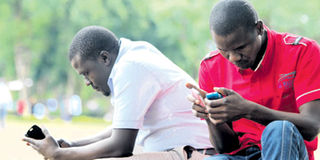Villages set to go hi-tech in Internet connection drive

Residents take advantage of free Wi-Fi at a hotspot in the Jomo Kenyatta Sports Ground in Kisumu on June 2, 2015. The Kakamega County government is set to roll out a programme that will ensure that villagers will access the Internet. PHOTO | TOM OTIENO | NATION MEDIA GROUP
What you need to know:
- The county government is currently running a programme known as “OparanyaCare”, which encourages women to give birth at hospitals.
- The project was funded by the United States Agency for International Development, NetHope and Intel, in partnership with World Vision and the Kenyan government.
- World Vision’s programme manager for Matete Sub-County, Mr Moses Kiptugen, said: “For women who can access and use it, ICT offers potential, especially in terms of reducing poverty, improving governance, overcoming isolation and providing a voice.
The Kakamega County government has unveiled an ambitious plan to connect villages to the Internet.
ICT and E-government County Executive Sebastian Machisu said schools, health institutions, village polytechnics, public libraries and cyber-cafes would be included in the project.
“The county is finalising plans to install a connection right from the head offices to the 12 sub-counties, the 60 wards and eventually the over 160 villages,” Mr Machisu told the Nation in Eldoret Town yesterday.
He said ICT centres and “digital villages” would be set up in various areas for service delivery and to improve residents’ access to information.
He said the facilities would also help spur development and investment in rural areas.
“As a regional government, we wish to take services as close to the people as possible. We (will) serve everyone from their homesteads, instead of having a situation where they walk long distances to access these facilities,” said the official.
The county government is currently running a programme known as “OparanyaCare”, which encourages women to give birth at hospitals. Expectant mothers who heed the call receive financial assistance after they have been registered. This, according to Mr Machisu, had doubled the number of pregnant women who opt to deliver at hospitals.
At the same time, more than 270 women last week graduated under the “Women and the Web” project in Chimoi Sub-County.
The project was funded by the United States Agency for International Development, NetHope and Intel, in partnership with World Vision and the Kenyan government. The participants were mainly taught how to apply computer skills to business and entrepreneurship.
“While there is recognition of the potential of ICT as a tool for the promotion of gender equality and the empowerment of women, a gender divide has also been identified.
“It is reflected in the low number of women accessing and using ICT compared with men. Unless this gender divide is addressed, there is a risk that ICT may exacerbate existing inequalities between women and men. It may also create new forms of inequality,” said Mr Machisu.
World Vision’s programme manager for Matete Sub-County, Mr Moses Kiptugen, said: “For women who can access and use it, ICT offers potential, especially in terms of reducing poverty, improving governance, overcoming isolation and providing a voice.
“However, persistent gender discrimination in labour markets and education, and in the allocation of financial resources for entrepreneurship (undermines) women’s potential to fully utilise ICT for economic, social and political empowerment,” he added.




